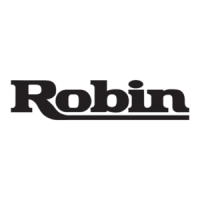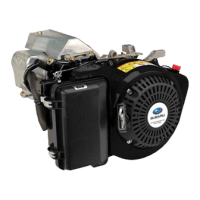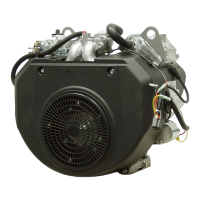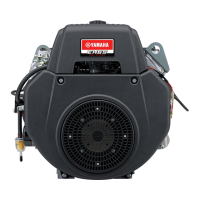
Do you have a question about the Robin America EX13 and is the answer not in the manual?
| Brand | Robin America |
|---|---|
| Model | EX13 |
| Category | Engine |
| Language | English |
Describes the maximum output of an engine with throttle fully open and parts broken in.
Output at optimum governed speed, most favorable for engine life and fuel consumption.
Torque at the output shaft when producing maximum output at a specific RPM.
Graphs showing output and torque characteristics for the EX13D engine.
EX engines are quieter and softer in tone due to OHC system and optimized muffler.
Reliable starting and less pulling force achieved via compression release and new combustion chamber.
High parts commonality simplifies maintenance and lowers repair costs, allowing tool-free tasks.
Features heavy-duty chain driven OHC, new main bearing cover design, superior cooling/lubrication.
Achieves higher power and lower fuel consumption via pentroof combustion chamber and straight intake port.
Cylinder and crankcase are single-piece aluminum die-casting with an integrated cast iron liner.
Aluminum die-casting cover mounted on the output shaft side for easy engine interior inspection.
Made of spheroidal graphite cast iron, induction-hardened crank pin, with pressed-on sprockets.
Heat-treated aluminum alloy connecting rod and piston with grooves for compression and oil rings.
Piston rings made of special cast iron with specific profiles for top, second, and oil rings.
Camshaft and sprocket made of sintered alloy, featuring intake/exhaust cams and a decompression release lever.
Features chain-driven overhead cam and overhead valve construction for intake and exhaust.
Aluminum die-casting with pent roof combustion chamber, with intake/exhaust ports arranged for efficiency.
Centrifugal flyweight type governor for maintaining constant engine speed under varying loads.
Forced air-cooling system using a fan (also flywheel) to direct air to the cylinder and head.
Lubrication of rotating and sliding parts via splashing engine oil from the connecting rod splasher.
Timing chain system engaged between camshaft and crankshaft sprockets for lubricating upper cylinder head.
Transistor controlled magneto system with fixed ignition timing, consisting of flywheel and ignition coil.
Horizontal draft carburetor calibrated for optimum all-round performance and general-purpose use.
Quieter air cleaner using semi-wet urethane foam element, with optional dual element.
(Provided only in Model EX27D) Cancels unbalanced inertia force by rotating at crankshaft speed to reduce vibration.
Automatic system on camshaft that opens exhaust valve at compression top to ease recoil starting.
Illustrates a cross-sectional view of the engine, showing key components and their layout.
Key steps and advice before disassembling, including memorizing parts and using correct tools.
Lists specialized tools required for disassembly, such as a flywheel puller.
Step-by-step guide for disassembling the engine, starting with draining the oil.
Outlines the process for reassembling engine components after disassembly.
Crucial points to consider during reassembly, including cleaning and checking parts.
Detailed steps and precautions for assembling specific engine components like the oil sensor and crankshaft.
Explains API oil grade classifications and recommended grades for Robin Engines.
Details SAE oil viscosity classifications and their relation to ambient temperature.
Provides guidelines for engine oil inspection, filling, and changing intervals.
Describes the T.I.C. type breakerless magneto ignition system standard specification.
Procedures for checking the magneto for defects if the engine has starting or running issues.
Details the T.I.C. pointless ignition system used in EX13, 17, and 21 models.
Identifies the T.I.C. system and optional components like lamp coil.
Explains how the step advancing ignition timing system works for easier starting.
Explains the ignition system for the EX27 model, including circuit and timing characteristics.
Diagram of the internal circuit of the ignition coil for the EX27.
Graph showing the linear advancing ignition timing characteristic for the EX27.
Explains the basic theory behind the EX27 ignition system's timing control.
Wiring diagram for models without an electric starter.
Wiring diagram for EX17 and 21 models equipped with an electric starter.
Wiring diagram for the EX27 model with an electric starter.
Wiring diagram illustrating the optional oil sensor system.
Provides specifications for the electric starter for models EX17, 21, and EX27.
Explains the operating principles of the electric starter system, including magnetic switch and pinion gear engagement.
Illustrates the component parts of the electric starter for EX17 and EX21 models.
Flowchart for diagnosing and resolving engine starting issues related to the electric starter.
Specifies the type, resistance, and operating temperature range of the oil sensor.
Explains the composition and working principle of the oil sensor, involving a float and magnetic switch.
Details the function and construction of the automatic decompression system for easier engine starting.
Guidance on inspecting the release lever mechanism for smooth operation.
Lists carburetor specifications like A/C Type, Main Jet, and Pilot Jet for different models.
Explains the functions and construction of the float, pilot, main, and choke systems within the carburetor.
Provides procedures for disassembling and reassembling the carburetor, highlighting common malfunctions.
Details the recoil starter and lists required tools and initial disassembly precautions.
Step-by-step instructions for disassembling the recoil starter mechanism.
Step-by-step instructions for reassembling the recoil starter components.
Procedures to check the recoil starter's functionality after reassembly.
Additional tips for handling springs during disassembly and lubrication.
General advice on engine installation, considering ease of access for maintenance.
Importance of proper ventilation to prevent overheating and ensure normal engine function.
Guidelines for exhaust systems, including pipe diameter based on length and safety cover recommendations.
Considerations for fuel tank height, piping, and preventing air/vapor lock.
Recommendations for belt drive and flexible coupling installation for power transmission.
Notes on using V-belts, alignment, and tension for belt drives.
Advice on minimizing run-out and misalignment when using flexible couplings.
Lists conditions for satisfactory engine start and common starting difficulties with causes and remedies.
Provides standard dimensions and wear limits for engine parts like cylinder head and crankshaft.
Lists specified tightening torques for various engine components like cylinder head bolts and muffler nuts.
Daily maintenance tasks including cleaning, checking for leaks, and oil level.
Initial inspection and maintenance after 20 hours of operation, primarily changing crankcase oil.
Maintenance schedule for every 100 hours, including oil change, air cleaner cleaning, and spark plug inspection.
Monthly maintenance covering fuel strainer, fuel tank cleaning, and air cleaner element replacement.
Maintenance checks every 300 hours, focusing on valve clearance inspection.
Periodic maintenance every 6 months, involving cylinder head carbon removal and carburetor cleaning.
Annual maintenance procedures including engine overhaul, piston ring replacement, and fuel hose replacement.
Steps for preparing the engine for storage, including draining fuel, oiling cylinder bore, and cleaning exterior.











